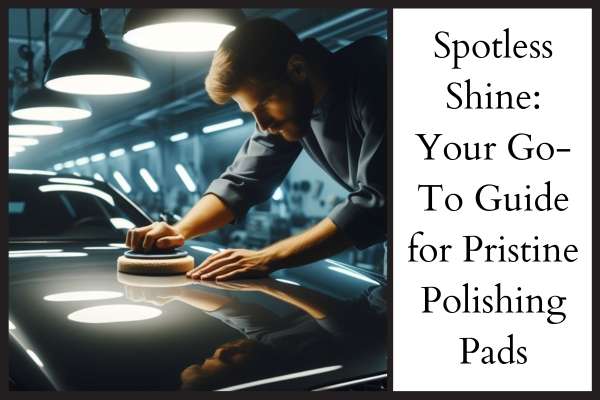
Dec 14,2023
When it comes to achieving that perfect shine on your surfaces, having the right tools is crucial. Polishing pads play a significant role in this process, offering a seamless way to bring out the best in your surfaces. In this comprehensive guide, we'll delve into the world of polishing pads, exploring their types, usage, and how to maintain that spotless shine. So, let's embark on a journey to discover the secrets behind pristine polishing pads.
Before we dive into the nitty-gritty details, let's establish a foundational understanding of what polishing pads are. Polishing pads are specialized tools designed to enhance the appearance of surfaces through the process of polishing. They come in various materials, each serving a unique purpose in the quest for a spotless shine.
Foam pads are incredibly versatile, making them a staple in any polishing kit. The foam's softness varies, with denser options for more robust tasks and softer ones for delicate finishes. These pads adapt to different surfaces, including car exteriors, countertops, and furniture, providing a flawless shine without causing damage.
Whether buffing out minor scratches on your vehicle or adding the final touch to your wooden coffee table, foam pads offer the flexibility needed for a perfect finish. Their adaptability makes them a favorite among DIY enthusiasts and professionals alike.
When you need precision and a superior shine, microfiber pads step up to the plate. Their exceptional polishing capabilities make them ideal for surfaces that require extra care. These pads excel at removing fine particles, leaving your surfaces gleaming with a professional finish, whether it's your car's paint or your favorite glass tabletop.
Microfiber pads are like magic wands for achieving that showroom finish. The microscopic fibers delve into surface imperfections, lifting away even the tiniest particles. Whether you're a car detailing enthusiast or a homeowner aiming for perfection, microfiber pads are a must-have for achieving that spotless shine that stands out.
For more challenging tasks like restoring weathered paint or dealing with deep scratches, wool pads are the heavyweights of the polishing world. Their coarse texture and ability to handle heavy-duty polishing make them indispensable for achieving a smooth, glossy finish on demanding surfaces.
Wool pads are the workhorses of the polishing world. When standard pads fall short, wool pads rise to the occasion. They tackle oxidation on your car's exterior, revive worn wooden surfaces, and can even be your go-to for metal polishing. If you have a challenging task, wool pads are your reliable partners for a spotless shine.
Selecting the appropriate polishing pad is crucial for achieving optimal results. Consider the following factors:
Different surfaces demand different types of pads. Always match the pad material to the surface you are working on to avoid damage or subpar results. Whether it's metal, wood, or glass, there's a pad designed to bring out its best.
Polishing pads come in varying grit levels, indicating their abrasiveness. Lower grits are coarser and suitable for heavy-duty polishing, while higher grits are finer and ideal for achieving a mirror-like finish on delicate surfaces.
The size and shape of the pad also play a role in its effectiveness. Smaller pads are perfect for intricate details, while larger ones cover more significant areas quickly. Choose accordingly based on the size and intricacy of the surface you're polishing.
Selecting the right pad involves a thoughtful analysis of your specific needs. Combining wool and microfiber pads might be your winning formula if you're restoring a vintage car. For everyday surfaces, a reliable foam pad could be your go-to choice. Understanding these factors ensures that you not only achieve the desired shine but also do so efficiently and without causing unintended damage.
Proper care is essential to ensure the longevity and efficiency of your polishing pads. Here are some tips to keep them in prime condition:
After each use, clean your polishing pads thoroughly. Remove any residue or particles that may have accumulated during the polishing process. This ensures a consistent performance every time you use them.
Cleaning your pads is not just a maintenance task; it's a crucial step in preserving their effectiveness. A quick rinse or soak in an appropriate cleaning solution can make a significant difference in the lifespan of your pads. By investing a little time in cleaning, you're ensuring that each polishing session delivers the best possible results.
Store your polishing pads in a cool, dry place away from direct sunlight. Avoid compressing them, as this can affect their shape and, consequently, their performance.
Proper storage is often overlooked but is a key factor in maintaining the integrity of your polishing pads. Exposure to sunlight and extreme temperatures can degrade the materials over time. By storing them in a controlled environment, you're not just extending their lifespan but also preserving their effectiveness for years to come.
To prevent uneven wear, rotate your polishing pads regularly. This simple practice ensures that each pad part gets equal use, maximizing its lifespan.
Rotating your pads might seem like a small detail, but it can make a big difference in their longevity. Pads wear unevenly based on the pressure and motions applied during polishing. Regularly switching them around evens out the wear and tear, ensuring that each pad maintains its effectiveness for a more extended period.
In conclusion, achieving a spotless shine with your surfaces is an art; the right polishing pads are your brushes. Understanding the types of pads, strategically choosing them based on your needs, and maintaining them correctly are the keys to unlocking a world of brilliance. So, armed with this knowledge, embark on your polishing journey, confident that every swipe brings you closer to the impeccable shine you desire. Here's to spotless surfaces and a gleaming finish that stands out in every setting!